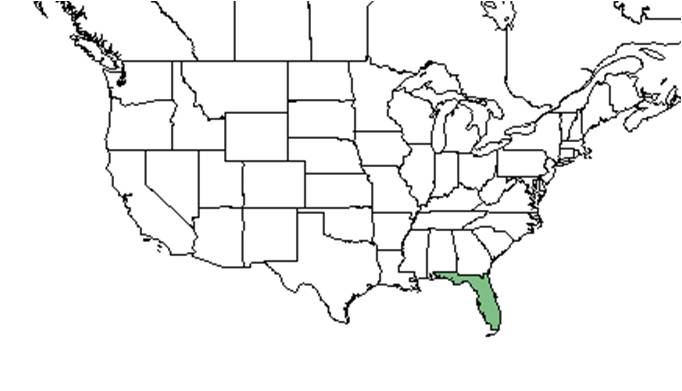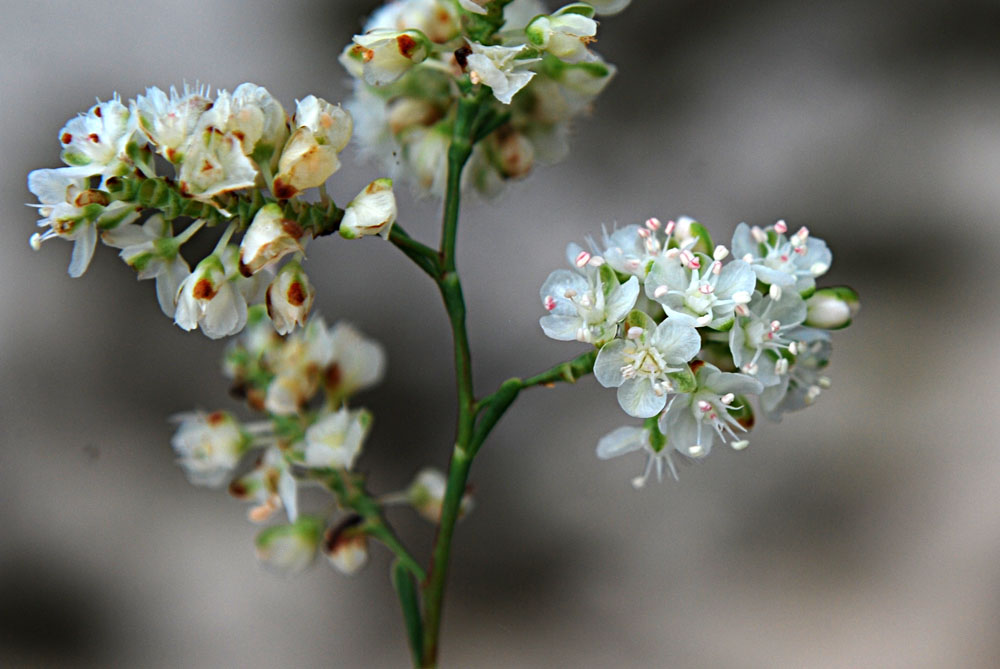Difference between revisions of "Polygonum dentoceras"
KatieMccoy (talk | contribs) |
HaleighJoM (talk | contribs) (→Ecology) |
||
| (26 intermediate revisions by 5 users not shown) | |||
| Line 3: | Line 3: | ||
{{taxobox | {{taxobox | ||
| name = Polygonum dentoceras | | name = Polygonum dentoceras | ||
| − | | image = | + | | image = Poly_myri_Poly_dent2.jpg |
| − | | image_caption = | + | | image_caption = ''Polygonella myriophylla'' shown, synonym of ''Polygonum dentoceras'' Photo by Wayne Matchett, [http://www.spacecoastwildflowers.com SpaceCoastWildflowers.com] |
| regnum = Plantae | | regnum = Plantae | ||
| divisio = Magnoliophyta - Flowering plants | | divisio = Magnoliophyta - Flowering plants | ||
| Line 18: | Line 18: | ||
}} | }} | ||
| − | Common | + | Common names: Sandlace, Small's jointweed |
==Taxonomic notes== | ==Taxonomic notes== | ||
| − | + | Synonyms: ''Polygonella myriophylla'' (Small) Horton; ''Dentoceras myriophylla'' Small | |
==Description== | ==Description== | ||
| Line 27: | Line 27: | ||
==Distribution== | ==Distribution== | ||
| − | It is endemic to the ridges of central Florida<ref name="fnai">[[http://www.fnai.org/FieldGuide/pdf/Polygonella_myriophylla.PDF]] Florida Natural Areas Inventory. Accessed: February 24, 2016</ref> | + | It is endemic to the ridges of central Florida.<ref name="fnai">[[http://www.fnai.org/FieldGuide/pdf/Polygonella_myriophylla.PDF]] Florida Natural Areas Inventory. Accessed: February 24, 2016</ref> |
==Ecology== | ==Ecology== | ||
===Habitat=== <!--Natural communities, human disturbed habitats, topography, hydrology, soils, light, fire regime requirements for removal of competition, etc.--> | ===Habitat=== <!--Natural communities, human disturbed habitats, topography, hydrology, soils, light, fire regime requirements for removal of competition, etc.--> | ||
| − | It is found in the dry sands of Florida rosemary scrubs in central Florida<ref name="fsu">Florida State University Robert K. Godfrey Herbarium database. URL: [http://herbarium.bio.fsu.edu http://herbarium.bio.fsu.edu]. Last accessed: February 2016. Collectors: L.J. Brass, D. Burch, George R. Cooley, Chas. C. Deam, Robert K. Godfrey, O. Lakela, Robert Kral, S.W. Leonard, John K. Small, D.B. Ward, Kenneth A. Wilson, Carrol E. Wood. States and Counties: Florida: DeSoto, Highlands, Polk. Compiled by Tall Timbers Research Station and Land Conservancy.</ref> | + | It is found in the dry sands of Florida rosemary scrubs in central Florida.<ref name="fsu">Florida State University Robert K. Godfrey Herbarium database. URL: [http://herbarium.bio.fsu.edu http://herbarium.bio.fsu.edu]. Last accessed: February 2016. Collectors: L.J. Brass, D. Burch, George R. Cooley, Chas. C. Deam, Robert K. Godfrey, O. Lakela, Robert Kral, S.W. Leonard, John K. Small, D.B. Ward, Kenneth A. Wilson, Carrol E. Wood. States and Counties: Florida: DeSoto, Highlands, Polk. Compiled by Tall Timbers Research Station and Land Conservancy.</ref> It is a gap specialist and has allelopathic properties, specifically to grasses.<ref name="weidenhamer">Weidenhamer, J. D., D. C. Hartnett, et al. (1989). "Density-Dependent Phytotoxicity: Distinguishing Resource Competition and Allelopathic Interference in Plants." Journal of Applied Ecology 26(2): 613-624.</ref> |
===Phenology=== <!--Timing off flowering, fruiting, seed dispersal, and environmental triggers. Cite PanFlora website if appropriate: http://www.gilnelson.com/PanFlora/ --> | ===Phenology=== <!--Timing off flowering, fruiting, seed dispersal, and environmental triggers. Cite PanFlora website if appropriate: http://www.gilnelson.com/PanFlora/ --> | ||
| − | Reproduces sexually and asexually<ref name="fws"/> | + | Reproduces sexually and asexually.<ref name="fws"/> Fruits and flowers all year.<ref name="fnai"/> |
| + | <!--===Seed dispersal===--> | ||
| + | ===Seed bank and germination=== | ||
| + | It is an obligate seeder.<ref name=weekley">Weekley, C. W. and E. S. Menges (2003). "Species and Vegetation Responses to Prescribed Fire in a Long-Unburned, Endemic-Rich Lake Wales Ridge Scrub." The Journal of the Torrey Botanical Society 130(4): 265-282.</ref> | ||
| − | |||
| − | |||
===Fire ecology=== <!--Fire tolerance, fire dependence, adaptive fire responses--> | ===Fire ecology=== <!--Fire tolerance, fire dependence, adaptive fire responses--> | ||
| − | It is believed that ''P. dentoceras'' is not dependent on fire, however only depends on sufficient gaps<ref name="fws">. It demonstrates allelopathic capabilities | + | It is believed that ''P. dentoceras'' is not dependent on fire, however only depends on sufficient gaps.<ref name="fws">[[https://www.fws.gov/verobeach/MSRPPDFs/Sandlace.PDF]]Accessed: February 24, 2016</ref> It demonstrates allelopathic capabilities that may create suitable conditions and maintain enough bare sand needed. It does not resprout after fire, Weekley and Menges (2003) observed that two years postburn, ''P. dentoceras'' had not recolonized most plots. This is an obligate seeder and will recolonize from seeds after time. |
| − | |||
| − | |||
| − | |||
| − | Halictidae | + | ===Pollination === |
| + | ''Polygonum dentoceras'' was observed at the Archbold Biological Station to host sweat bees from the Halictidae family such as ''Lasioglossum placidensis'', wasps from the Leucospididae family such as ''Leucospis robertsoni'', thread-waisted wasps from the Sphecidae family such as ''Bembecinus nanus floridanus, Cerceris blakei'' and ''Tachytes pepticus'', and wasps from the Vespidae family such as ''Leptochilus krombeini'' and ''Stenodynerus beameri''.<ref name="Deyrup 2015">Deyrup, M.A. and N.D. 2015. Database of observations of Hymenoptera visitations to flowers of plants on Archbold Biological Station, Florida, USA.</ref> Additionally, ''P. dentoceras'' has been observed to host ground-nesting bees such as ''Andrena nigrocaerulea'', aphids such as ''Aphis sp.'' (family Aphididae), bees from the Apidae family such as ''Bombus impatiens'' and ''Trigona spinipes'', plasterer bees from the Colletidae family such as ''Colletes speculiferus'', leaf-footed bugs from the Coreidae family such as ''Leptoglossus phyllopus'', planthoppers from the Dictyopharidae family such as ''Scolops sulcipes'', sweat bees from the Halictidae family such as ''Augochlora pura, Augochloropsis metallica'' and ''Lasioglossum pilosum'', and plant bugs from the Miridae family such as ''Lygus lineolaris''.<ref>Discoverlife.org [https://www.discoverlife.org/20/q?search=Bidens+albaDiscoverlife.org|Discoverlife.org]</ref> | ||
| + | <!--===Herbivory and toxicology===<!--Common herbivores, granivory, insect hosting, poisonous chemicals, allelopathy, etc--> | ||
| + | <!--===Diseases and parasites===--> | ||
| − | + | ==Conservation, cultivation, and restoration== | |
| + | There are fewer than 150 populations of ''P. dentoceras'' remaining on the Lake Wales Ridge. The ridge is quickly being converted to urban and agricultural areas. This species requires a large-scale natural disturbance, such as fire, to maintain gaps in the scrub to allow for germination.<ref name="fnai"/> | ||
| − | + | US-Endangered | |
| − | + | FL-Endangered | |
| − | == | + | ==Cultural use== |
| − | |||
| − | |||
| − | |||
==Photo Gallery== | ==Photo Gallery== | ||
<gallery widths=180px> | <gallery widths=180px> | ||
| − | </gallery> | + | File:Polygonella_myri_Poly_DentFlowers_WMatchett_SpaceCoastWildfl307.jpg | <center> Flowers of ''Polygonella myriophylla'' synonym of ''Polygonum dentoceras'' <p> Photo by Wayne Matchett, [http://www.spacecoastwildflowers.com SpaceCoastWildflowers.com]</gallery> |
| − | |||
==References and notes== | ==References and notes== | ||
Deyrup, M.A. and N.D. 2015. Database of observations of Hymenoptera visitations to flowers of plants on Archbold Biological Station, Florida, USA. | Deyrup, M.A. and N.D. 2015. Database of observations of Hymenoptera visitations to flowers of plants on Archbold Biological Station, Florida, USA. | ||
Latest revision as of 10:13, 15 July 2022
| Polygonum dentoceras | |
|---|---|

| |
| Polygonella myriophylla shown, synonym of Polygonum dentoceras Photo by Wayne Matchett, SpaceCoastWildflowers.com | |
| Scientific classification | |
| Kingdom: | Plantae |
| Division: | Magnoliophyta - Flowering plants |
| Class: | Magnoliopsida – Dicotyledons |
| Order: | Caryophyllales |
| Family: | Polygonaceae |
| Genus: | Polygonum |
| Species: | P. dentoceras |
| Binomial name | |
| Polygonum dentoceras (Small) Horton | |

| |
| Natural range of Polygonum dentoceras from USDA NRCS Plants Database. | |
Common names: Sandlace, Small's jointweed
Contents
Taxonomic notes
Synonyms: Polygonella myriophylla (Small) Horton; Dentoceras myriophylla Small
Description
A description of Polygonum dentoceras is provided in The Flora of North America.
Distribution
It is endemic to the ridges of central Florida.[1]
Ecology
Habitat
It is found in the dry sands of Florida rosemary scrubs in central Florida.[2] It is a gap specialist and has allelopathic properties, specifically to grasses.[3]
Phenology
Reproduces sexually and asexually.[4] Fruits and flowers all year.[1]
Seed bank and germination
It is an obligate seeder.[5]
Fire ecology
It is believed that P. dentoceras is not dependent on fire, however only depends on sufficient gaps.[4] It demonstrates allelopathic capabilities that may create suitable conditions and maintain enough bare sand needed. It does not resprout after fire, Weekley and Menges (2003) observed that two years postburn, P. dentoceras had not recolonized most plots. This is an obligate seeder and will recolonize from seeds after time.
Pollination
Polygonum dentoceras was observed at the Archbold Biological Station to host sweat bees from the Halictidae family such as Lasioglossum placidensis, wasps from the Leucospididae family such as Leucospis robertsoni, thread-waisted wasps from the Sphecidae family such as Bembecinus nanus floridanus, Cerceris blakei and Tachytes pepticus, and wasps from the Vespidae family such as Leptochilus krombeini and Stenodynerus beameri.[6] Additionally, P. dentoceras has been observed to host ground-nesting bees such as Andrena nigrocaerulea, aphids such as Aphis sp. (family Aphididae), bees from the Apidae family such as Bombus impatiens and Trigona spinipes, plasterer bees from the Colletidae family such as Colletes speculiferus, leaf-footed bugs from the Coreidae family such as Leptoglossus phyllopus, planthoppers from the Dictyopharidae family such as Scolops sulcipes, sweat bees from the Halictidae family such as Augochlora pura, Augochloropsis metallica and Lasioglossum pilosum, and plant bugs from the Miridae family such as Lygus lineolaris.[7]
Conservation, cultivation, and restoration
There are fewer than 150 populations of P. dentoceras remaining on the Lake Wales Ridge. The ridge is quickly being converted to urban and agricultural areas. This species requires a large-scale natural disturbance, such as fire, to maintain gaps in the scrub to allow for germination.[1]
US-Endangered
FL-Endangered
Cultural use
Photo Gallery
Flowers of Polygonella myriophylla synonym of Polygonum dentoceras Photo by Wayne Matchett, SpaceCoastWildflowers.com
References and notes
Deyrup, M.A. and N.D. 2015. Database of observations of Hymenoptera visitations to flowers of plants on Archbold Biological Station, Florida, USA.
- ↑ 1.0 1.1 1.2 [[1]] Florida Natural Areas Inventory. Accessed: February 24, 2016
- ↑ Florida State University Robert K. Godfrey Herbarium database. URL: http://herbarium.bio.fsu.edu. Last accessed: February 2016. Collectors: L.J. Brass, D. Burch, George R. Cooley, Chas. C. Deam, Robert K. Godfrey, O. Lakela, Robert Kral, S.W. Leonard, John K. Small, D.B. Ward, Kenneth A. Wilson, Carrol E. Wood. States and Counties: Florida: DeSoto, Highlands, Polk. Compiled by Tall Timbers Research Station and Land Conservancy.
- ↑ Weidenhamer, J. D., D. C. Hartnett, et al. (1989). "Density-Dependent Phytotoxicity: Distinguishing Resource Competition and Allelopathic Interference in Plants." Journal of Applied Ecology 26(2): 613-624.
- ↑ 4.0 4.1 [[2]]Accessed: February 24, 2016
- ↑ Weekley, C. W. and E. S. Menges (2003). "Species and Vegetation Responses to Prescribed Fire in a Long-Unburned, Endemic-Rich Lake Wales Ridge Scrub." The Journal of the Torrey Botanical Society 130(4): 265-282.
- ↑ Deyrup, M.A. and N.D. 2015. Database of observations of Hymenoptera visitations to flowers of plants on Archbold Biological Station, Florida, USA.
- ↑ Discoverlife.org [3]
